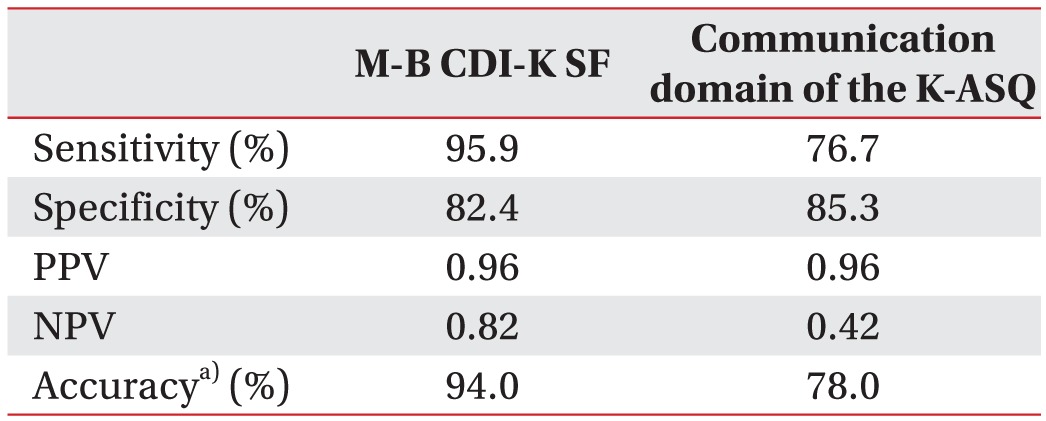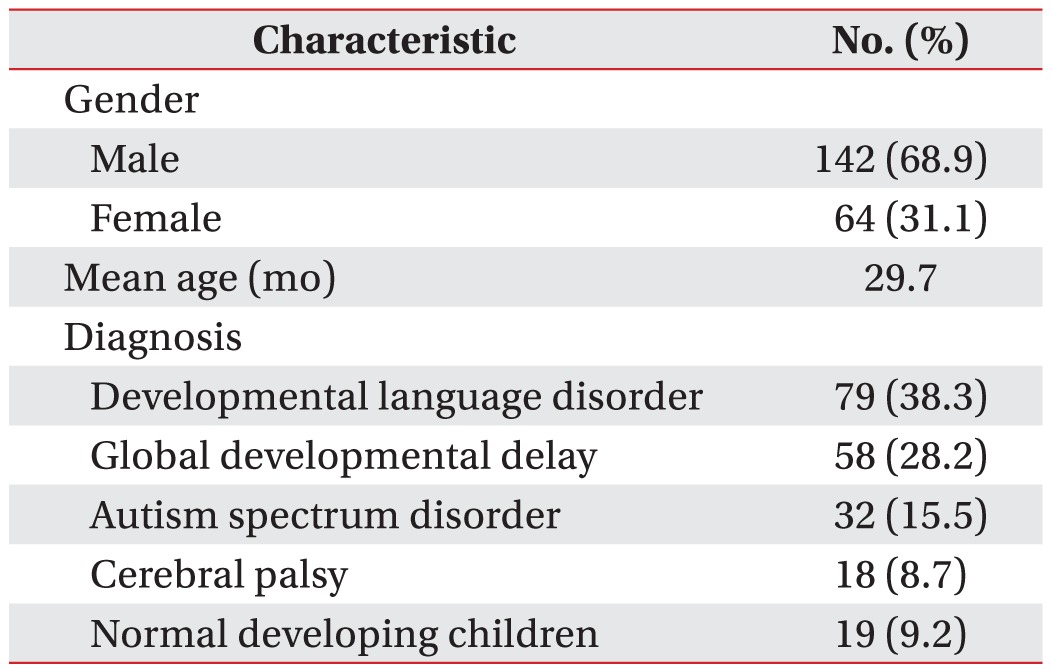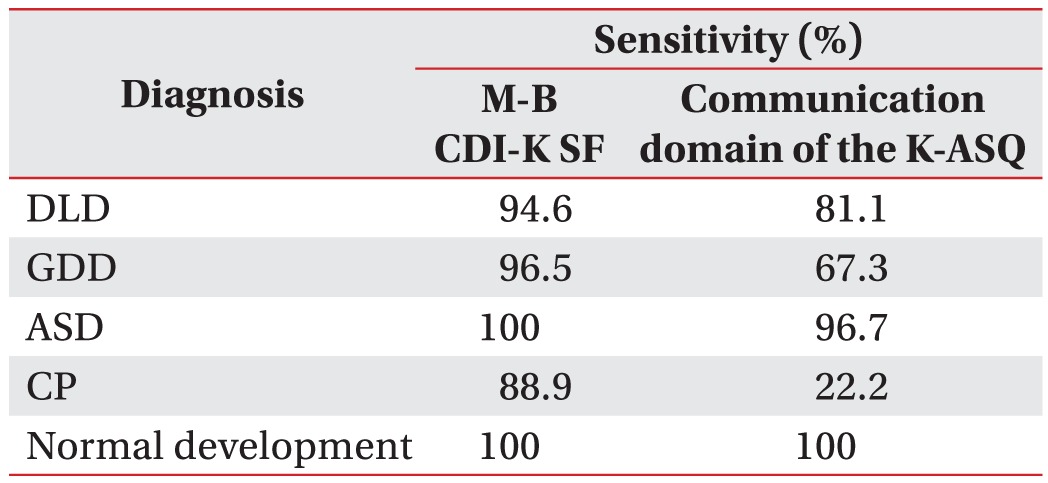1. Kim EY, Sung IK. The ages and stages questionnaire: screening for developmental delay in the setting of a pediatric outpatient clinic. Korean J Pediatr. 2007; 50:1061–1066.

2. Kim SW, Han ZA, Jeon HR, Choi JY, Chung HJ, Kim YK, et al. Neurodevelopmental disorders of children screened by the infantile health promotion system. Ann Rehabil Med. 2011; 35:867–872. PMID:
22506216.

3. Chung HJ, Eun BL, Kim HS, Kim JK, Shin SM, Lee JH, et al. The validity of Korean Ages and Stages Questionnaires (K-ASQ) in Korean infants and children. J Korean Child Neurol Soc. 2014; 22:1–11.
4. Shevell M, Majnemer A, Platt RW, Webster R, Birnbaum R. Developmental and functional outcomes in children with global developmental delay or developmental language impairment. Dev Med Child Neurol. 2005; 47:678–683. PMID:
16174311.

5. Ga HY, Kwon JY. A comparison of the Korean-ages and stages questionnaires and denver developmental delay screening test. Ann Rehabil Med. 2011; 35:369–374. PMID:
22506146.

6. Pae S, Yoon H, Gilkerson J, Lee H, Sung IK. Early language and communication screening: the sensitivity and specificity of the Korean-Age and Stage Questionnaires. Korean J Early Child Spec Educ. 2015; 15:167–179.
7. Kim SW, Jeon HR, Park EJ, Kim HI, Jung DW, Woo MR. The usefulness of M-B CDI-K Short Form as screening test in children with language developmental delay. Ann Rehabil Med. 2014; 38:376–380. PMID:
25024962.

8. Kim YT, Kim KH, Yoon HR, Kim HS. Sequenced language scale for infants (SELSI). 1st ed. Seoul: Special Education Publishing;2003.
9. Kim YT, Sung TJ, Lee YK. Preschool receptive-expressive language scale (PRES). 1st ed. Seoul: Seoul Community Rehabilitation Center;2003.
10. Boyle CA, Boulet S, Schieve LA, Cohen RA, Blumberg SJ, Yeargin-Allsopp M, et al. Trends in the prevalence of developmental disabilities in US children, 1997-2008. Pediatrics. 2011; 127:1034–1042. PMID:
21606152.

11. Jang JH, Park ES, Park JH, Baek JH, Won YH, Rha DW. Clinical usefulness of capute developmental test as a screening test for detecting the language delay. J Korean Acad Rehabil Med. 2010; 34:544–549.
12. Randall D, Reynell J, Curwen M. A study of language development in a sample of 3 year old children. Br J Disord Commun. 1974; 9:3–16. PMID:
4433458.

13. Burden V, Stott CM, Forge J, Goodyer I. The Cambridge Language and Speech Project (CLASP). I. Detection of language difficulties at 36 to 39 months. Dev Med Child Neurol. 1996; 38:613–631. PMID:
8674912.
14. Harel S, Greenstein Y, Kramer U, Yifat R, Samuel E, Nevo Y, et al. Clinical characteristics of children referred to a child development center for evaluation of speech, language, and communication disorders. Pediatr Neurol. 1996; 15:305–311. PMID:
8972529.

15. Eun JJ, Lee HJ, Kim JK. Developmental profiles of preschool children with delayed language development. Korean J Pediatr. 2014; 57:363–369. PMID:
25210524.

16. Rossman MJ, Hyman SL, Rorabaugh ML, Berlin LE, Allen MC, Modlin JF. The CAT/CLAMS assessment for early intervention services. Clinical Adaptive Test/Clinical Linguistic and Auditory Milestone Scale. Clin Pediatr (Phila). 1994; 33:404–409. PMID:
7525137.
17. Pae S, Kwak K, Kim M, Lee H, Jung K. Short form versions of MacArthur-Bates Communicative Development Inventories - Korean (M-B CDI-K). J Korean Soc Speech Sci. 2008; 15:119–129.
18. Visintainer PF, Leppert M, Bennett A, Accardo PJ. Standardization of the Capute Scales: methods and results. J Child Neurol. 2004; 19:967–972. PMID:
15704872.

19. Pae S. Validity and reliability of the Korean adaptation of MCDI. Korean J Commun Disord. 2003; 8:1–14.
20. Frisk V, Montgomery L, Boychyn E, Young R, vanRyn E, McLachlan D, et al. Why screening Canadian preschoolers for language delays is more difficult than it should be. Infants Young Child. 2009; 22:290–308.

21. Guiberson M, Rodriguez BL. Measurement properties and classification accuracy of two spanish parent surveys of language development for preschool-age children. Am J Speech Lang Pathol. 2010; 19:225–237. PMID:
20484705.

22. Guiberson M, Rodriguez BL, Dale PS. Classification accuracy of brief parent report measures of language development in Spanish-speaking toddlers. Lang Speech Hear Serv Sch. 2011; 42:536–549. PMID:
21844403.

23. Berkman ND, Wallace I, Watson L, Coyne-Beasley T, Cullen K, Wood C, et al. Screening for speech and language delays and disorders in children age 5 years or younger: a systematic review for the U.S. Preventive Services Task Force. Rockville: Agency for Healthcare Research and Quality;2015.






 PDF
PDF ePub
ePub Citation
Citation Print
Print







 XML Download
XML Download